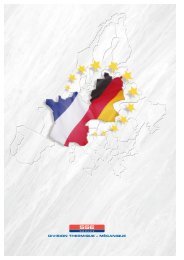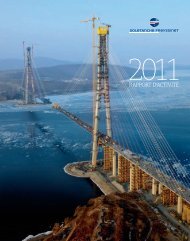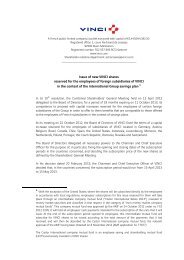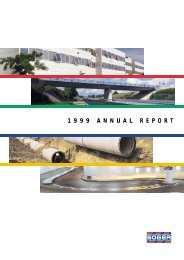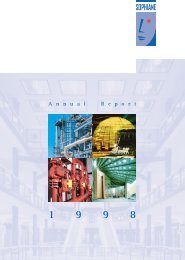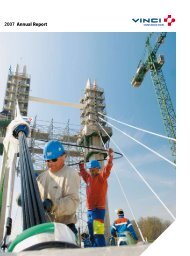VINCI - 2005 annual report
VINCI - 2005 annual report
VINCI - 2005 annual report
You also want an ePaper? Increase the reach of your titles
YUMPU automatically turns print PDFs into web optimized ePapers that Google loves.
1.3 CONCESSIONS<br />
The main risks in connection with Concession projects relate to design<br />
and construction (which are, however, usually borne by the undertakings<br />
in charge of the construction), to factors that can affect traffi c levels and<br />
to fi nancial variables (interest rates, infl ation, etc).<br />
1.4 ACQUISITIONS<br />
To control the risks connected with the integration of newly acquired<br />
companies and to be able to apply the Group’s management principles in<br />
them, <strong>VINCI</strong>’s policy is to acquire a majority interest in acquirees.<br />
2. MARKET AND LIQUIDITY RISKS<br />
2.1 LIQUIDITY RISK<br />
The Group’s exposure to liquidity risk relates to its obligations to repay its<br />
existing debt, in addition to the supplementary debt arising from the<br />
acquisition in progress of ASF and, ASF’s own debt. In particular, the fi nancing<br />
of this transaction includes a 7-year acquisition loan of €4.2 billion that<br />
provides for a fi nancial ratio that must be met throughout the period of<br />
the loan, failing which, the loan will become repayable.<br />
2.2 MARKET RISK (INTEREST RATE, CURRENCY AND EQUITY)<br />
<strong>VINCI</strong> is exposed to interest rate risk in connection with its fl oating-rate<br />
debt, and to currency risk in connection with its activities in foreign<br />
countries. However, as approximately 80% of the Group’s activities in<br />
foreign countries are in the eurozone, <strong>VINCI</strong>’s exposure to currency risk<br />
remains limited.<br />
Management of interest rate and currency risks is explained in Note 26<br />
to the consolidated fi nancial statements.<br />
REPORT OF THE BOARD<br />
Concession projects are systematically submitted to the Risk Committee<br />
for examination and agreement. In order to limit the risk capital invested<br />
by the Group, these projects are generally developed in partnership with<br />
outside enterprises and are fi nanced so as to maximise the amount of debt,<br />
which is generally with no or limited recourse against <strong>VINCI</strong>.<br />
Any proposed acquisition or disposal is submitted to the Risk Committee<br />
for agreement. The largest are also submitted to the Board of Directors<br />
after examination by the Strategy and Investment Committee (see paragraph<br />
3.2.2 of the Corporate Governance section).<br />
Details of these obligations and the Group’s resources enabling it to meet<br />
them (cash fl ow surpluses, unused confi rmed credit lines, fi nancial ratings)<br />
are given in Notes 25 and 26.2 to the consolidated fi nancial statements.<br />
<strong>VINCI</strong> has no exposure to equity risk. The Group no longer has any material<br />
unconsolidated holding in a listed company and the investment<br />
vehicles used to manage its cash surpluses are mainly monetary UCITS<br />
and negotiable debt securities.<br />
183




